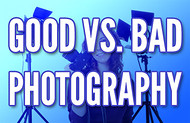Good Vs. Bad Photography In Web Design
Photography can make or break a website. Good photography can set a scene, express a company’s core values, pique curiosity and entice a visitor to dig deeper into the site. Bad photography can make a site or business look unprofessional, outdated, inflexible and incompetent. Here are just a few key ways you can use stock photography from companies like BigStockPhoto to lure those visitors in rather than turning them away at the door.
DO use photos that are well lit.
Unlit photos are aesthetically unappealing at best, confusing at worst. Improper lighting can make models look sickly or unpleasant, two adjectives you decidedly do not want associated with your brand. It can also obscure the true focus of the photo, whether that’s an object that’s the emotional core, or an actual product up for sale.
DON’T use photos with hard shadows from a flash.
When they appear unintentionally, hard shadows make a photograph look amateurish. They lend a harsh, cold air to the kind of softer photos you’ll likely want to feature on your site, highlighting only the worst aspects of the shot. First impressions are key; the first impression a hard shadow will have on a viewer is not one you want to have.
DO use photos that are professional looking.
Professional looking photos make a site look, well, professional. That translates directly into a favorable impression, making the brand featured look together, with it and trustworthy.
DON’T use photos that have been shot on a gloomy
day.
Humans are visual creatures. The photos you feature on a site will have a direct effect on the way users feel during and after their browse. Featuring shots of a gloomy day will engender negative or depressed feelings that will prevent visitors from returning or converting into customers.
DO use photos that show blue sky instead of gray or
a non-colored sky.
Aside from negativity, gray and non-colored skies are just boring. They sap all of the energy out of both the picture and the site. Blue skies, on the other hand, will fill visitors with warmth, energy and positivity.
DON’T use photos that are under-exposed
Nobody wants to see a dark underexposed photo. They just suck the life right out of the view and they broadcast the silent message that you, as the designer, has awful design skills and can’t discern a reasonable image from a drab lifeless one. Ouch!
DON’T use photos that are fuzzy.
Featuring crisp, clear photos is an essential part of looking professional. Keep it clean and and sharp and users won’t be able to get that image out of their heads.
DO feature models in up to date clothing.
Image: FreeDigitalPhotos.net
No matter what your industry, it’s important to create the impression that you keep up with the latest innovations. Featuring models in out of date clothing will do just the opposite. It will make you look stodgy, out of touch and unwilling to embrace change. In today’s rapidly morphing business environment, that’s a major no.
Photography is a simple yet powerful way to create a compelling, memorable website. Use it strategically, and you’re sure to up both conversions and your store of loyal followers. Design intentionally, design creatively, and always keep in mind these dos and don’ts.

